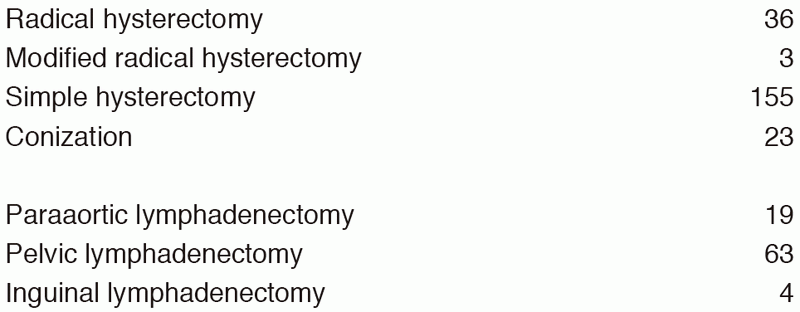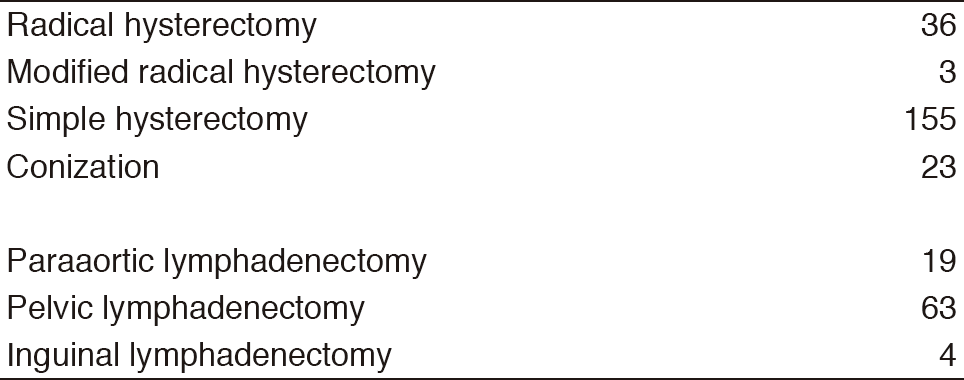Annual Report 2017
Department of Gynecology
Tomoyasu Kato, Shunichi Ikeda, Mitsuya Ishikawa, Takashi Uehara, Hanako Shimizu, Keisei Tate, Kenta Takahashi
Introduction
The Department of Gynecology deals with tumors originating from the female genital and reproductive organs. Surgery is the main treatment modality for most gynecologic cancers, but multidisciplinary treatments consisting of radiotherapy and chemotherapy are routinely considered in close cooperation with therapeutic radiation oncologists and medical oncologists. The incidence of three common gynecologic cancers: cervical, endometrial, and ovarian cancer, is now on the rise in Japan.
Our team and what we do
Dr. Shunichi Ikeda retired in June 2017 and we had one vacancy, but remaining four staff complemented outpatient clinical work. The number of hospitalized patients increased all the time, leading to a constant increase. Residents who are mainly responsible for ward work always seem to work in a three-resident system, and collaboration with co-medical has become closer. The number of surgeries during one year and three months (January 2017 ‐ March 2018) was 369, of which total radical hysterectomy increased from 20 cases per year to approximately 30 cases per year, and paraaortic lymph node dissection was also 19 cases. We conduct these radical surgeries safely and surely and continue to practice true minimally invasive treatment.
Research activities
Advanced ovarian cancers are highly metastatic due to frequent peritoneal dissemination, resulting in dismal prognosis. In collaboration with the Division of Molecular and Cellular Medicine, National Cancer Center Research Institute (NCCRI), the following results were obtained. The cancer EVs efficiently induce apoptotic cell death in human mesothelial cells in vitro and in vivo, thus resulting in the destruction of the peritoneal mesothelium barrier. Whole transcriptome analysis shows that MMP1 is significantly elevated in mesothelial cells treated with highly metastatic cancer EVs and intact MMP1 mRNAs are selectively packaged in the EVs. MMP1 mRNA-
carrying EVs exist in the ascites of cancer patients and these EVs also induce apoptosis in mesothelial cells. Our findings elucidate a previously unknown mechanism of peritoneal dissemination via EVs.
Table 1. Number of patients (January 2017-March 2018)

Table 2. Type of procedures (January 2017-March 2018)

Clinical trials
1) A non-randomized confirmatory trial of modified radical hysterectomy for patients with FIGO Stage Ib1 (< 2 cm) uterine cervical cancer (JCOG1101) is ongoing as planned.
2) A non-randomized verification study
regarding selection of fertility-sparing surgery for patients with epithelial ovarian cancer (JCOG1203) is ongoing as planned.
3) A randomized phase II/III trial conventional paclitaxel and carboplatin versus dose-dense paclitaxel and carboplatin in stage IVB, recurrent, or persistent cervical carcinoma (JCOG 1311) has been amended.
4) A randomized phase III trial to confirm survival effect of para-aortic lymphadenectomy for patients with endometrial cancer (JCOG1412) has started.
5) A non-randomized confirmatory trial of postoperative concurrent chemotherapy (CCRT) using IMRT for patients with curatively resected high-risk uterine cervical cancer has been submitted.
Education
Chief resident doctor 1
Resident doctor 6
Future prospects
Laparoscopic surgery for uterine malignant disease and robot assisted laparoscopic surgery for uterine malignant disease are now covered by Japanese health insurance. We are working diligently to meet facility requirements and operator requirements. In addition, we are pursuing "the safe execution of radical surgery" and collaborating with the NCCRI to break through the existing treatment outcomes.
List of papers published in January 2017 - March 2018
Journal
1. Nakamura S, Okamoto H, Wakita A, Umezawa R, Takahashi K, Inaba K, Murakami N, Kato T, Igaki H, Ito Y, Abe Y, Itami J. A management method for the statistical results of patient-specific quality assurance for intensity-modulated radiation therapy. J Radiat Res, 58:572-578, 2017
2. Mitsuhashi A, Uehara T, Hanawa S, Shozu M. Prospective evaluation of abnormal glucose metabolism and insulin resistance in patients with atypical endometrial hyperplasia and endometrial cancer. Support Care Cancer, 25:1495-1501, 2017
3. Yokoi A, Yoshioka Y, Yamamoto Y, Ishikawa M, Ikeda SI, Kato T, Kiyono T, Takeshita F, Kajiyama H, Kikkawa F, Ochiya T. Malignant extracellular vesicles carrying MMP1 mRNA facilitate peritoneal dissemination in ovarian cancer. Nat Commun, 8:14470, 2017
4. Kihara A, Yoshida H, Watanabe R, Takahashi K, Kato T, Ino Y, Kitagawa M, Hiraoka N. Clinicopathologic Association and Prognostic Value of Microcystic, Elongated, and Fragmented (MELF) Pattern in Endometrial Endometrioid Carcinoma. Am J Surg Pathol, 41:896-905, 2017
5. Miyoshi Y, Yorifuji T, Horikawa R, Takahashi I, Nagasaki K, Ishiguro H, Fujiwara I, Ito J, Oba M, Fujisaki H, Kato M, Shimizu C, Kato T, Matsumoto K, Sago H, Takimoto T, Okada H, Suzuki N, Yokoya S, Ogata T, Ozono K. Childbirth and fertility preservation in childhood and adolescent cancer patients: a second national survey of Japanese pediatric endocrinologists. Clin Pediatr Endocrinol, 26:81-88, 2017
6. Shimizu H? shikawa T? Iitsuka C? Homma M? Takimoto M? Sekizawa A. Early-onset primary peritoneal carcinoma from atypical cells after risk-reducing salpingo-oophorectomy for BRCA2 mutation carrier: a case report. Int Canc Conf J, 6:104-108, 2017
7. Sekii S, Murakami N, Kato T, Harada K, Kitaguchi M, Takahashi K, Inaba K, Igaki H, Ito Y, Sasaki R, Itami J. Outcomes of salvage high-dose-rate brachytherapy with or without external beam radiotherapy for isolated vaginal recurrence of endometrial cancer. J Contemp Brachytherapy, 9:209-215, 2017
8. Ebata T, Yunokawa M, Yoshida H, Bun S, Shimoi T, Shimomura A, Kodaira M, Yonemori K, Shimizu C, Fujiwara Y, Kato T, Tamura K. The Prognostic Impact of the Pathological Response to Neoadjuvant Dose-Dense Therapy for Ovarian Carcinoma. Int J Gynecol Cancer, 27:1850-1855, 2017
9. Yokoi A, Yoshioka Y, Hirakawa A, Yamamoto Y, Ishikawa M, Ikeda SI, Kato T, Niimi K, Kajiyama H, Kikkawa F, Ochiya T. A combination of circulating miRNAs for the early detection of ovarian cancer. Oncotarget, 8:89811-89823, 2017
10. Tate K, Watanabe R, Yoshida H, Shimizu H, Uehara T, Ishikawa M, Ikeda SI, Hiraoka N, Kato T. Uterine adenosarcoma in Japan: Clinicopathologic features, diagnosis and management. Asia Pac J Clin Oncol, 2018
11. Kanke Y, Shimomura A, Saito M, Honda T, Shiraishi K, Shimada Y, Watanabe R, Yoshida H, Yoshida M, Shimizu C, Takahashi K, Totsuka H, Ogiwara H, Hirose S, Kono K, Tamura K, Okamoto A, Kinoshita T, Kato T, Kohno T. Gene aberration profile of tumors of adolescent and young adult females. Oncotarget, 9:6228-6237, 2018
12. Yoshida H, Ikeda S, Tsukada T, Watanabe R, Hiraoka N, Kato T. Methods for Measuring and Staging a Uterine Cervical Adenocarcinoma Showing Intracystic Papillary Growth: A Case Report. Int J Gynecol Pathol, 37:364-367, 2018
13. Ishikawa M, Kasamatsu T, Tsuda H, Fukunaga M, Sakamoto A, Kaku T, Nakanishi T, Hasumi Y, Iwata T, Baba T, Nogawa T, Kudaka W, Kaneda H, Ono S, Saito F, Taniguchi Y, Okada S, Mizuno M, Onda T, Yaegashi N. Prognostic factors and optimal therapy for stages I-II neuroendocrine carcinomas of the uterine cervix: A multi-center retrospective study. Gynecol Oncol, 148:139-146, 2018
14. Sasada S, Yunokawa M, Takehara Y, Ishikawa M, Ikeda S, Kato T, Tamura K. Baseline risk of recurrence in stage I-II endometrial carcinoma. J Gynecol Oncol, 29:e9, 2018
